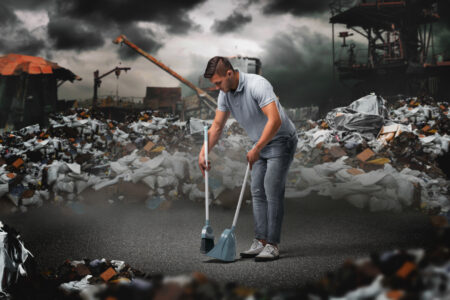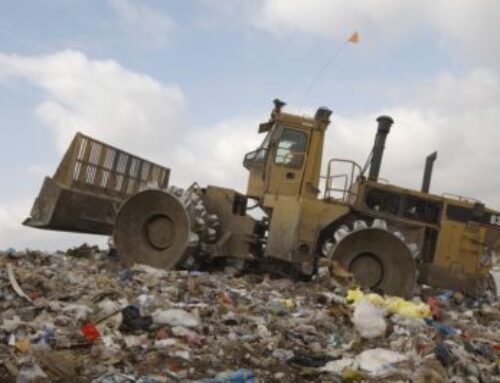Waste Disposal and its dangers have long been a concern of large and even small cities. Improper waste disposal can create serious hazards for both man and beast. This is especially true because we see so much of it.
The US generates over 258 million tons of solid waste each year. This includes:
- All the packaging.
- Old clothing.
- Bottles and cans.
- Food Scraps.
- Newspapers.
- And all the other items that find their way into garbage cans and landfills.
Waste Disposal: Serious Concern

Diminishing Space to Hold Our Landfill Waste.
Our owners and staff at Consolidated Waste Systems have long been concerned about the proper disposal and processing of waste both from our neighborhoods and commercial sources. The differences in types of waste material are unknown to most individuals.
For example, most families are unaware that food and other organic items generate methane and carbon dioxide. This happens naturally, as these items decay. Likewise, they are unaware of the dangerous chemicals we inadvertently throw away. These chemicals eventually find their way into landfill areas.
Thus, even if the landfill operators are following regulations and procedures, careless human beings increase the possibility of hazardous waste polluting the water, earth, and the air.
“We’re Gonna Need a Bigger Planet”
Re-Mat Recycling article printed this headline in 2017. The reference was to the overwhelming volume of waste being sent to our landfill sites across the United States each year. The article added, that our massive landfills were beginning to present “enormous challenges for the health of our planet…” And they added we were quickly “creating toxic environments, impacts to human health, and yet-to-be-understood long-term issues.”
Those 2017 writers also stated wryly that landfills were “are just plain ugly.” Now, four years later, we are complicating the problem further. You see, landfill space is becoming scarce. Our landfills are getting “full.”
Landfill Crisis, Not Just a Challenge
Space for landfills is extremely limited over the entire United States. Many major eastern cities are exporting trash to other states instead of sending it to local landfills.
The reason is partly due to available space, but also because landfills are so unpopular. Let’s face it, no one wants to live near such an ugly and smelly place. And did I mention the word dangerous?
Proximity to Landfills Can Be Hazardous to Your Health

Will Our Next Generation Think Before They Throw Something In The Trash? It’s Up To You.
Here are 2 examples that reveal how living or working near landfills can be a serious threat to your health.
1. A study by the New York State Department of Health released in June 1998 reports the dangers of cancer. Researchers stated that “women living near solid waste landfills where gas is escaping have a four-fold increased chance of bladder cancer or leukemia (cancer of the blood-forming cells).”
2. Another incident occurred during the 1980s. Four New York Giants football players developed cancer. As a result, the team and coachers demanded repeated water and soil tests. It seems the Giant’s Stadium was built over a notorious landfill site.
The researchers found no conclusive evidence to support the football players’ fears. However, researchers rank the New Jersey site, the so-called “Garden State,” as “4th in states with highest rates of cancer nationwide…” No wonder researchers developed a new nickname for New Jersey, calling it the “Garbage State.”
Later occurrences seemed to refute the “non-conclusive evidence.” Aug. 24, 1987, The Los Angeles Times reported suspicious coincidences:
- Nelson has Hodgkin’s Disease.
- Former Giant running back Doug Kotar died in 1983 from a cancerous brain tumor.
- John Tuggle died last year from lung cancer.
- Linebacker Dan Lloyd’s National Football League career ended in 1980 due to lymph node cancer.
It’s worth noting that Giants Stadium is built on a landfill in an area with one of the highest cancer rates in the country. The Giants vacated that site in 2010.
The Most Dangerous Landfills: Old Waste Sites

An Ocean Of Waste Requires Careful Management. If You Are Drowning, Call Consolidated Waste Systems. We Can Help.
Many believe that the most dangerous landfills are the oldest. This comes as no surprise because such places started accepting waste before protective regulations were in effect.
- The most dangerous sites date were created before 1980. Companies or cities constructed these landfills “under rules that did not really protect people or the surrounding environment.”
- As a result, we now know “the landfill may have accepted highly toxic waste that it should not have.”
- Additionally, older landfills often did not have effective liners or they had no liners at all. This means there is nothing to stop pollution. We now know ineffective liners invite contamination. This happens “as gravity and percolation from the rain pushes it down toward the groundwater.”
Adding to this problem is the fact that cities and companies neglected to adequately design or construct the sides of the landfills. And therefore, many of the pre-1980 landfills offered no resistance to methane gas explosions. This has often occurred.
Waste Disposal: The Good
The government continually updates EPA regulations. Thus, they constantly increase the safety of humans, animals, and the environment. Additionally, we believe that operators of landfill sites are faithfully trying to fulfill those regulations.
And yet, even with the best of intentions and diligence, problems occur. For example, hazardous chemicals sometimes contaminate sites. Then, serious consequences result.
Waste Disposal: The Bad and The Ugly
Unfortunately, the Bad and the Ugly can also be found. These are the individual and business owners who put a quick dollar ahead of the good of the community.
Two business partners set up a business involving the dumping and recycling of shingles in southeast Dallas. The scheme was to charge truckers for dumping shingles and then grind up the shingles. The resulting product was believed to be a viable pot-hole filler.
The plan seemed like a great money-maker. However, it spawned terrifying results for the community. It should be noted the business partners reportedly did neither apply for nor received the appropriate permissions from the City of Dallas. The partners created “Shingle Mountain.”
Waste Disposal: The Victims
Have you ever heard of “Shingle Mountain?”
A lady by the name of Marsha Jackson is more than a little familiar with the mountain. The mountain grew to 60 feet. And it spread up to her backyard and next to her bedroom. This was a mountain of shingles.
The situation worsened as the shingles were ground up, spreading a fog of debris into the air over the community.
The City’s Pollution Analysis

Managing Waste And Cleaning-up Landfills Is The Way We Protect The Families Of The Future.
The city’s hazardous waste analysis determined that “shingles have small glass fibers and formaldehyde that become airborne when they are ripped apart.” And they added that “breathing dust from crushed shingles may cause temporary irritation of the nose and throat…” And that “Ingestion may cause short term…irritation of the stomach and intestines. And then, “vomiting can occur.”
This was the air Ms. Martha Jackson and her 12-year-old grand-daughter had been breathing for approximately 2 years. The report stated that it took approximately 3 years (including court decisions) to begin the removal of “Shingle Mountain.”
We are certain that you find this story as depressing as we do. However, it is only one of the many ugly stories in the history of modern waste.
In the next part of our series on the modern history of waste and regulation, we hope to bring you some more encouraging news. Yes, we see our ability to control our waste is improving with modern methods and technology. Manufacturing is also beginning to self-regulate and cease using toxic materials we can not recycle or destroy. Just the same, ultimately, much depends on you, the consumer.
Now, will you think twice before you throw those dead batteries or that old laptop in your regular garbage pick-up?
Next week, discover why we changed “Jolly Old England’s ” name to “Dirty Old England.” As always, we of Consolidated Waste Systems thank you for reading our blog. We constantly strive to bring you a better understanding of how waste management affects life in our city, our country, and the planet. See more about us and what we can do for your business on our services page.



